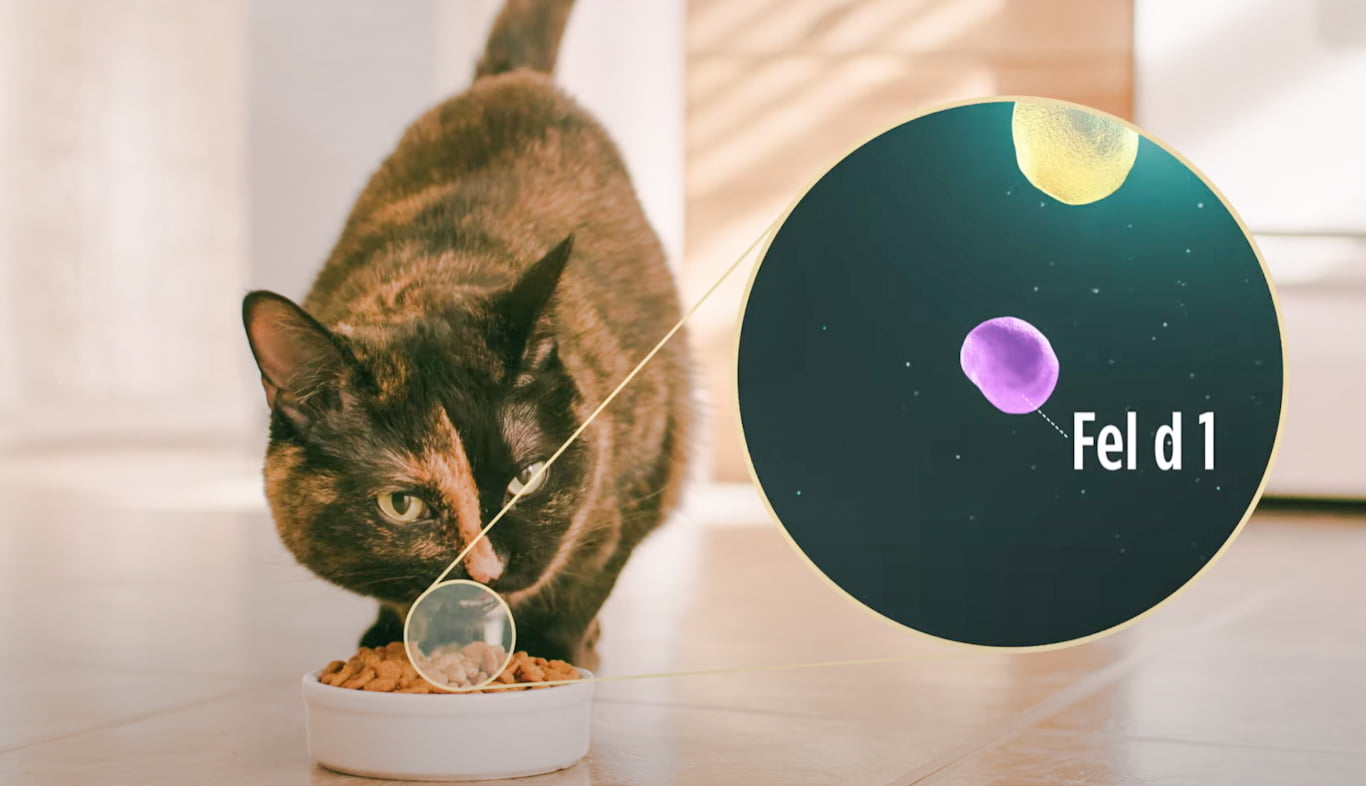I had hoped to write that the wait might be over for cat lovers who seek a truly hypoallergenic cat. But not so, I am afraid. But this Utopian world is on the horizon. It will happen because there is lots of money to be made 😎. Cat lovers who are allergic to cats may have noticed that there’s been a flurry of work on making cats hypoallergenic. Around 10% of the population is allergic to a protein in cat saliva called Fel D1. The symptoms of the allergy can prevent cat lovers adopting a cat. Although, that said, there are a significant number of cat owners who are allergic to cats. They find a way around the problem but it can’t be easy.

The word “hypoallergenic” does not mean that a cat is completely free of the allergen that causes an immune reaction in some people. It means that there is less of a reaction. There are two projects to achieve the hypoallergenic cat, one of which is complete and on the shelves at the moment and the other which is still work in progress.
RELATED: Cat Allergen Fel D1
Food which suppresses the Fel D1 protein
The former project resulted in Purina’s PRO PLAN LIVE CLEAR, a cat food which is claimed to reduce the allergens in cat hair and dander by an average of 47% in the third week of feeding. The video below explains how it works. As I recall the food results in the Fel D1 being coated which prevents it taking effect and causing an allergic reaction.
Gene-editing
A more dramatic and long-awaited goal is to create a domestic cat which does not produce this irritating protein in their saliva. There have been previous attempts at this. You may remember Allerca cats (2004). They were claimed to be hypoallergenic. The project fizzled out and failed. But times have moved on and science today is more sophisticated.
Scientists can actually edit out the Fel D1 gene which creates this protein causing an allergic reaction. In other words, it is believed that it is currently possible to create cats which are truly hypoallergenic because they will not create the allergen.
In fact, on February 1, 2020, a scientific paper was published in The Journal of Allergy and Clinical Immunology which reported that the gene editing process called CRISPR-Cas9 successfully deleted from cats Fel D1 cells. The conclusion was that the process “is a viable tool for deleting the major cat allergen, Fel D1, from cat cells”. And they believed that the results of the test suggested that CRISPR “will serve as a viable approach for gene editing Fel D1 in cats”. They believed that it may “enable cat allergic patients to have cats while alleviating allergic symptoms”.
RELATED: Some individual cats are hypoallergenic for Fel d1
An important finding is that in knocking out these cells the cat is unharmed. There must have been a question mark on the outcome as to whether cats would be harmed. However, because there is a large variation in the Fel D1 gene they decided that the gene may not be that important to cats. This in turn means that when they remove the gene there will be no detrimental effect upon a genetically modified cat.
The goal is to create a gene-editing drug which a veterinarian can inject into a cat to delete the Fel D1-producing gene. This is the Holy Grail of hypoallergenic cats. Unfortunately, I think it will be a few years before we arrive at that Utopian place.
Biological function of this allergen
An interesting aspect of this research is that the scientists don’t know why cats have this allergen in their saliva. What benefit is it to cats? Scientists and cat owners know that domestic cats make the allergen in great quantities and spread it over their fur when they groom themselves. But we don’t know how spreading the allergen over their fur benefits them. What does it do for cats?
How did this gene evolve? Is it some kind of defensive measure? It appears not. It is not clear from my research whether the wild cat species also create this allergen. It’s important to know. Can it be argued that only domestic cats produce the Fel D1 allergen? And if so, is it some kind of deliberate barrier between the domestic cat and humans?
It appears that the gene that creates this allergen is different in lions and other big cats. We don’t know much more so one wonders whether this is a domestic cat evolutionary process and if so, why should the domestic cat produce an allergen which is detrimental to millions of people and the human-to-cat relationship?

